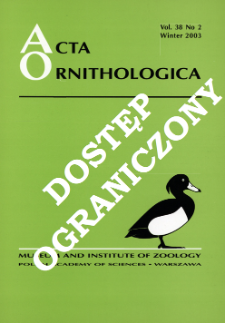
Object
Title: Breeding habitat selection in the house martin Delichon urbica in the city of Valencia (Spain)
Subtitle:
Acta Ornithologica, vol. 37, no. 2 ; Wybiórczość środowiskowa oknówki w mieście Walencji, Hiszpania ; Habitat selection of house martin
Contributor:
Polska Akademia Nauk. Muzeum i Instytut Zoologii
Publisher:
Muzeum i Instytut Zoologii PAN
Place of publishing:
Description:
Bibliogr. s. 82-83 ; S. [75]-83 : il. ; 27 cm ; Streszcz. pol. Nazwy taksonów także w jęz. łac.
Type of object:
Abstract:
The distribution of breeding House Martins was examined in relation to the characteristics of the urban landscape and the structure of the buildings. The study area (73 km2) was divided into 700 x 700 m squares. Ten habitat characteristics were measured within a circle of 300 m radius around each colony. Each nest site was classified according to nest-support-type, its height and orientation. Habitat features around colonies were compared with places at the center of those squares without colonies. Stepwise multiple regression was then used to assess the possible contribution of the independent variables to the size of the colonies. A total of 1399 nests were found, distributed in 120 colonies, mostly consisting of 1-5 nests. In the built-up area, the density reached 31.85 nests per km2. House Martins selected areas with a larger proportion of old buildings and open spaces, and closer to the nearest sources of food or mud. Only the distance from colonies to the nearest mud source and the proportion of open spaces were included in the regression model. As far as nest-sites are concerned, 33% of all nests were built under eaves, 34 % under the ledges of balconies with architectonic ornamentation, and 15 % within balconies. Birds selected nest sites offering better adhesion of nests to the substrate; to compensate for poorer adhesion, the number of nest walls touching other nests was increased. There was a positive relation between nest site height and building height. Nests were not uniformly distributed around the circle, but no clear patterns emerged from the data.
Relation:
Volume:
Issue:
Start page:
End page:
Detailed Resource Type:
Format:
Resource Identifier:
Source:
MiIZ PAN, patrz sygn. czas. P.257-37-2 ; MiIZ PAN, patrz sygn. czas. P.4568-37-2 ; click here to follow the link
Language:
Rights:
Prawa zastrzeżone - dostęp ograniczony
Terms of use:
Digitizing institution:
Muzeum i Instytut Zoologii Polskiej Akademii Nauk
Original in:
Biblioteka Muzeum i Instytutu Zoologii PAN
Projects co-financed by:
Program Operacyjny Innowacyjna Gospodarka, lata 2010-2014, Priorytet 2. Infrastruktura strefy B + R ; Unia Europejska. Europejski Fundusz Rozwoju Regionalnego
Access:
Object collections:
- Digital Repository of Scientific Institutes > Partners' collections > Museum and Institute of Zoology PAS > Scientific Journals
- Digital Repository of Scientific Institutes > Partners' collections > Museum and Institute of Zoology PAS > MIZ PAN Publications > Acta Ornithologica
- Digital Repository of Scientific Institutes > Literature > Journals/Articles
Last modified:
Oct 2, 2020
In our library since:
Jun 10, 2014
Number of object content downloads / hits:
94
All available object's versions:
https://rcin.org.pl/publication/55575
Show description in RDF format:
Show description in RDFa format:
Show description in OAI-PMH format:
| Edition name | Date |
|---|---|
| Breeding habitat selection in the house martin Delichon urbica in the city of Valencia (Spain) / Murgui, Enrique | Oct 2, 2020 |
Objects Similar
Kamiński, Piotr Wołosiuk, Bohdan
Myrcha, Alina Maria (1939– ) Jaroszewicz, Marta
Kamiński, Piotr Choiński, Andrzej Wołosiuk, Bohdan
Kamiński, Piotr Wołosiuk, Bohdan Choiński, Andrzej
Population density and breeding ecology of the house martin Delichon urbica in Pomerania (NW Poland)
Górska, Ewa
Ptaszyk, Jerzy
Kuźniak, Stanisław (1933– )
Zieliński, Piotr Wojciechowski, Zbigniew

 INSTYTUT ARCHEOLOGII I ETNOLOGII POLSKIEJ AKADEMII NAUK
INSTYTUT ARCHEOLOGII I ETNOLOGII POLSKIEJ AKADEMII NAUK
 INSTYTUT BADAŃ LITERACKICH POLSKIEJ AKADEMII NAUK
INSTYTUT BADAŃ LITERACKICH POLSKIEJ AKADEMII NAUK
 INSTYTUT BADAWCZY LEŚNICTWA
INSTYTUT BADAWCZY LEŚNICTWA
 INSTYTUT BIOLOGII DOŚWIADCZALNEJ IM. MARCELEGO NENCKIEGO POLSKIEJ AKADEMII NAUK
INSTYTUT BIOLOGII DOŚWIADCZALNEJ IM. MARCELEGO NENCKIEGO POLSKIEJ AKADEMII NAUK
 INSTYTUT BIOLOGII SSAKÓW POLSKIEJ AKADEMII NAUK
INSTYTUT BIOLOGII SSAKÓW POLSKIEJ AKADEMII NAUK
 INSTYTUT CHEMII FIZYCZNEJ PAN
INSTYTUT CHEMII FIZYCZNEJ PAN
 INSTYTUT CHEMII ORGANICZNEJ PAN
INSTYTUT CHEMII ORGANICZNEJ PAN
 INSTYTUT FILOZOFII I SOCJOLOGII PAN
INSTYTUT FILOZOFII I SOCJOLOGII PAN
 INSTYTUT GEOGRAFII I PRZESTRZENNEGO ZAGOSPODAROWANIA PAN
INSTYTUT GEOGRAFII I PRZESTRZENNEGO ZAGOSPODAROWANIA PAN
 INSTYTUT HISTORII im. TADEUSZA MANTEUFFLA POLSKIEJ AKADEMII NAUK
INSTYTUT HISTORII im. TADEUSZA MANTEUFFLA POLSKIEJ AKADEMII NAUK
 INSTYTUT JĘZYKA POLSKIEGO POLSKIEJ AKADEMII NAUK
INSTYTUT JĘZYKA POLSKIEGO POLSKIEJ AKADEMII NAUK
 INSTYTUT MATEMATYCZNY PAN
INSTYTUT MATEMATYCZNY PAN
 INSTYTUT MEDYCYNY DOŚWIADCZALNEJ I KLINICZNEJ IM.MIROSŁAWA MOSSAKOWSKIEGO POLSKIEJ AKADEMII NAUK
INSTYTUT MEDYCYNY DOŚWIADCZALNEJ I KLINICZNEJ IM.MIROSŁAWA MOSSAKOWSKIEGO POLSKIEJ AKADEMII NAUK
 INSTYTUT PODSTAWOWYCH PROBLEMÓW TECHNIKI PAN
INSTYTUT PODSTAWOWYCH PROBLEMÓW TECHNIKI PAN
 INSTYTUT SLAWISTYKI PAN
INSTYTUT SLAWISTYKI PAN
 SIEĆ BADAWCZA ŁUKASIEWICZ - INSTYTUT TECHNOLOGII MATERIAŁÓW ELEKTRONICZNYCH
SIEĆ BADAWCZA ŁUKASIEWICZ - INSTYTUT TECHNOLOGII MATERIAŁÓW ELEKTRONICZNYCH
 MUZEUM I INSTYTUT ZOOLOGII POLSKIEJ AKADEMII NAUK
MUZEUM I INSTYTUT ZOOLOGII POLSKIEJ AKADEMII NAUK
 INSTYTUT BADAŃ SYSTEMOWYCH PAN
INSTYTUT BADAŃ SYSTEMOWYCH PAN
 INSTYTUT BOTANIKI IM. WŁADYSŁAWA SZAFERA POLSKIEJ AKADEMII NAUK
INSTYTUT BOTANIKI IM. WŁADYSŁAWA SZAFERA POLSKIEJ AKADEMII NAUK


































